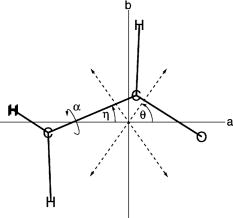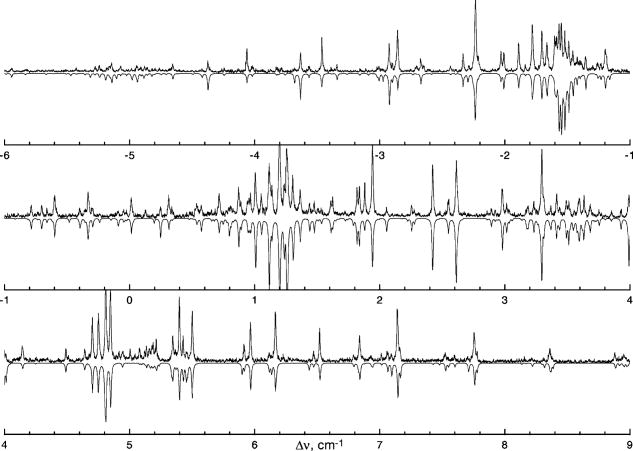E. Jalviste, G. Berden, M. Drabbels, and A.M. Wodtke.
J. Chem. Phys. 114 (2001), 8316-8327.
Copyright 2001 American Institute of Physics. This article may be found at J. Chem. Phys. 114, 8316 (2001)
 Acetaldehyde (CH3CHO) in its ground state is one of the simplest and best-studied prototype systems for investigating the spectroscopic manifestations of the coupling between the overall rotation of the molecule and the methyl torsion large amplitude motion.
The n pi*-type S1<--S0 electronic transition, whose vibronic bands cover the near UV spectral region (350-250 nm), provides access to the first excited singlet state of acetaldehyde. Owing to the out-of-CCO-plane equilibrium position of the aldehydic hydrogen in the S1 state, the inversion (wagging) vibration of this atom with respect to the CCO plane is the second large amplitude motion besides the methyl torsion.
In contrast to the very detailed global analysis of the ground-state data of acetaldehyde, little is known on the electronic transitions where the coupling between overall rotation and methyl torsion is consistently taken into account in the rotational analysis of the S1<--S0 electronic bands. This work attempts to fill this gap for the two lowest-frequency vibronic bands of S1<--S0 transition, the origin and the inversion band. Rotationally resolved excitation spectra of jet-cooled acetaldehyde are measured with a pulse-amplified cw laser system and analyzed with frequency as well as with intensity fitting techniques.
The results can be found in our paper.
Acetaldehyde (CH3CHO) in its ground state is one of the simplest and best-studied prototype systems for investigating the spectroscopic manifestations of the coupling between the overall rotation of the molecule and the methyl torsion large amplitude motion.
The n pi*-type S1<--S0 electronic transition, whose vibronic bands cover the near UV spectral region (350-250 nm), provides access to the first excited singlet state of acetaldehyde. Owing to the out-of-CCO-plane equilibrium position of the aldehydic hydrogen in the S1 state, the inversion (wagging) vibration of this atom with respect to the CCO plane is the second large amplitude motion besides the methyl torsion.
In contrast to the very detailed global analysis of the ground-state data of acetaldehyde, little is known on the electronic transitions where the coupling between overall rotation and methyl torsion is consistently taken into account in the rotational analysis of the S1<--S0 electronic bands. This work attempts to fill this gap for the two lowest-frequency vibronic bands of S1<--S0 transition, the origin and the inversion band. Rotationally resolved excitation spectra of jet-cooled acetaldehyde are measured with a pulse-amplified cw laser system and analyzed with frequency as well as with intensity fitting techniques.
The results can be found in our paper.
